The British brand Arcam has benefited for a long time from an excellent reputation with music lovers and home cinema enthusiasts, and its devices are well thought out, which means that the product ranges from the manufacturer aren’t renewed every time a pseudo-novelty or new fashion appears on the market.
Arcam developed its products in three ranges, the major one being the FMJ that includes stereo and multichannel elements, integrated amplifiers, a stereo preamplifier, stereo amplifiers, an audio/video processor, a CD player and a Blu-ray player.
The rSeries consists of “small” devices in line with the aspirations of the vinyl nostalgia fans, thanks to the rPhono, or of the Hi-Tech aficionados thanks to the rBlink and irDAC-II DACs, the rPlay streamer, the Musicboost case with DAC and headphone amplifier for the iPhone 6, or even the rHead headphone amplifier.
And finally, the Solo range, composed of lifestyle products, was established in 2005 and now includes the Muso Loudspeaker compact speaker, the Solo bar sound bar, the Solo sub subwoofer, the Solo Music all-in-one system and its two variations suitable for home cinema, the Solo Movie 2.1 and the Solo Movie 5.1. These products all come with a remote and can be driven via the Arcam Control application, and you can access Qobuz in Hi-Res thanks to the Arcam Music Life streaming application. Both Arcam applications are only available for iOS.
The Solo Music displays an elegant design and includes in the same box a CD/SACD player, a network player, a FM/DAB tuner and comes with S/PDIF and USB A digital inputs, as well as two analog inputs, one of which will allow you to connect a turntable, and is equipped, of course, with a stereo amplifier operating in class G calling upon two supply voltages for the power stages—a low voltage for most operations, and a higher commuted voltage for high amplitude moments. As it is, it’s only missing speakers.
Let’s now dive into the Qobuz testing ground, outdoor and indoor, of this Arcam Solo Music all-in-one system.
Arcam Solo Music
||About the Arcam Solo Music system|| |Type:|All-in-one system with network player, S/PDIF and HDMI digital inputs, CD/SACD player, tuner, and which includes the Qobuz application in Hi-Res| |Function:|Transforms digital audio data into analog signals and amplifies them to drive speakers| |Digital inputs:|S/PDIF (1 x coaxial, 1 x optical), USB A, network on RJ45 socket and Wi-Fi, Bluetooth aptX, 4 x HDMI and 1 x HDMI output, FM/DAB tuner| |Analog inputs:|Auxiliary on 3.5 mm Jack, phono| |Digital-to-analog converter:|Cirrus Logic CS42528 (24-Bit/192 kHz)| |Audio outputs:|Headphone on 3.5 mm Jack, subwoofer on RCA| |Amplifier:|class G, 2 x 80W/8 Ω, 2 x 125W /4 Ω| |Dimensions (L x H x P) :|420 x 90 x 410| |Weight:|25.35 lbs (11.5 kg)| |Design/Manufacturing:|England/China| |R.R.P.:|About 2200 euros| |Contact:|PPL Audio|
Presentation
The Arcam Solo Music all-in-one system is a very nice looking device which can be said to display charm and sweetness with a natural brushed anodized aluminum façade, its top part curving in quarter circle to meet the top panel.
The facade is crossed by a black stripe hosting, with much discretion, the source selection via two keys (forward or backward); the key allowing you to open or close the disc tray, which is barely discernable; a green dot matrix display, not that big but very legible, even from 6 or 10 feet; and three command keys (play/pause, skip forward and skip back) that you can use with the CD player.

In the bottom part of the facade, you’ll find, on the right, the start button, in chromed metal and slightly concave to adapt itself to the human finger and activating a real switch. The 3.5 mm headphone Jack located on the far left is donned with a hubcap similar to the one from the start button, obviously for the sake of visual balance.
On the forward part of the top side of the box, you’ll find a round panel with commands placed around a central black disc with concave embossing that allows you to adjust the volume. A remote that comes with the device lets you access to each and every function, with direct and non-sequential access to the sources, like on the facade.
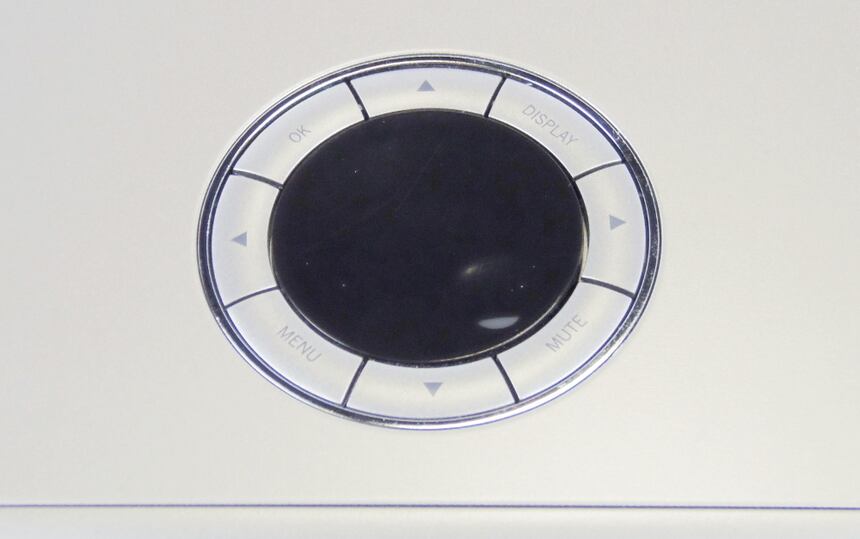
Connectivity
The Arcam Solo Music offers a rich collection of inputs that is almost exclusively digital, aside from the analog phono input on RCA and a discreet 3.5 mm Jack auxiliary input.
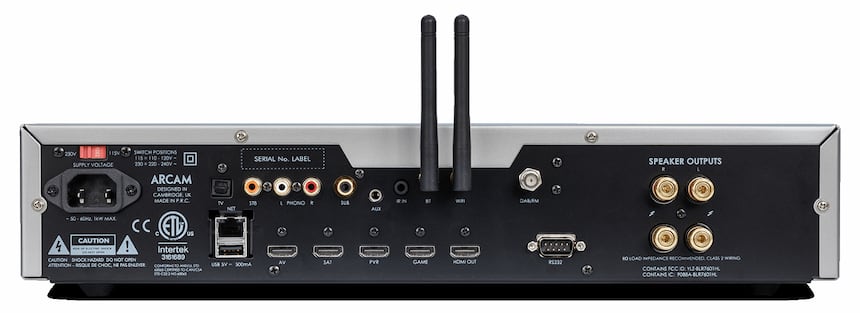
Let’s start with the RJ45 network socket in its block combined with a USB A socket designed for USB media storage, the whole being topped with two digital S/PDIF ports. Then come four HDMI inputs and one HDMI output from which the device will be able to extract and decode the sound in stereo while restituting the entirety of the audio and video signals through the HDMI output that will be connected to the TV.
A 3.5 mm Jack for an infrared remote receiver is located next to the Bluetooth and Wi-Fi antennas, then you’ll find the FM/DAB antenna connector, and under this, an RS232 connector to be controlled by a home automation system. Finally, two pairs of connectors will allow you to connect the speakers.
Manufacturing
As with every all-in-one system, the inside is relatively full, but it’s still kept reasonable and clean, which is almost always the case with Arcam. You can notice that the toroidal transformer for the power supply isn’t a cheap model and that the filtering of the amplifiers’ high and low supplies are handled by four Nichicon capacitors, two 22.000 μF/35V and two 10.000 μF/63V. Besides them is located the reading mechanism for the CD and SACD made by Sony.
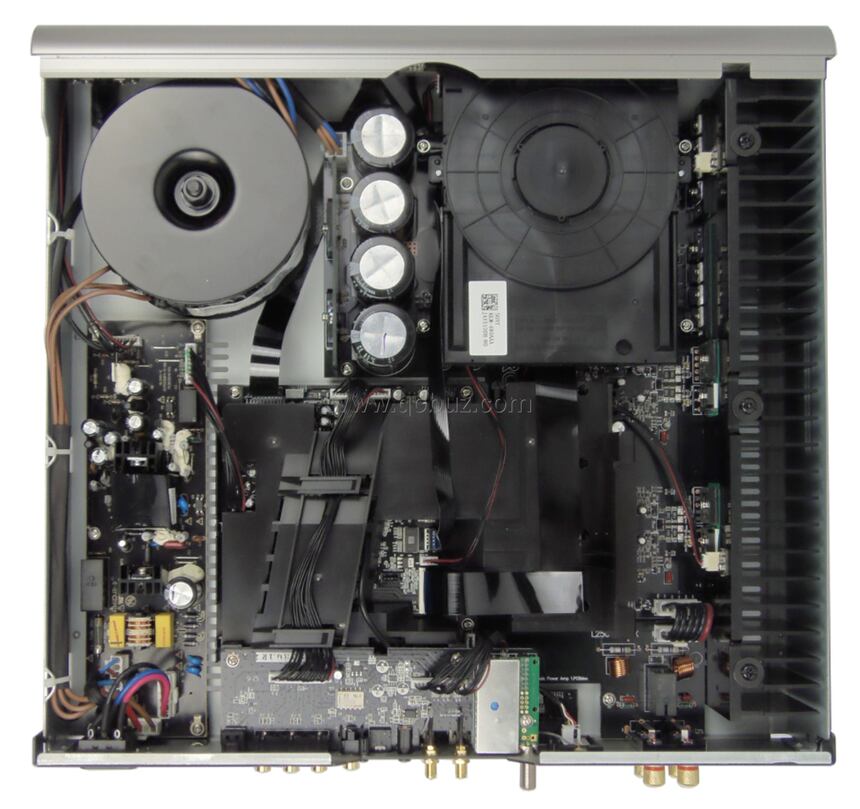
Some part of the space next to the transformer is occupied by the switching supply for the digital circuits and the control circuits, as well as the standby power and its relay that cuts down the main power.
You can see in the picture below the card hosting the analog RCA plugs for the phono input and the subwoofer out, the coaxial and optical S/PDIF inputs, the Jack auxiliary input as well as the one for the infrared signals, and the tuner FM/DAB module.
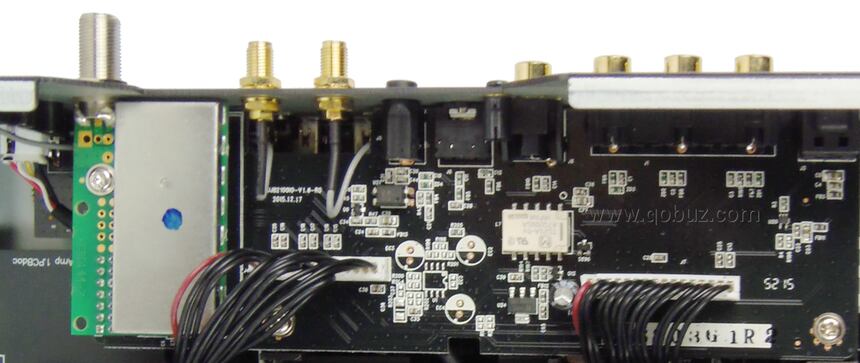
This card hides the HDMI inputs and output that are handled by a Silicon Image (Lattice) Sil9535 circuit. You can see on the left of the HDMI plugs the RJ45/USB-A combined block, and on the right the aptX Bluetooth receiver and the Wi-Fi module mounted on the back side. You’ll also find two Wolfson WM8804 receivers for the S/PDIF inputs.
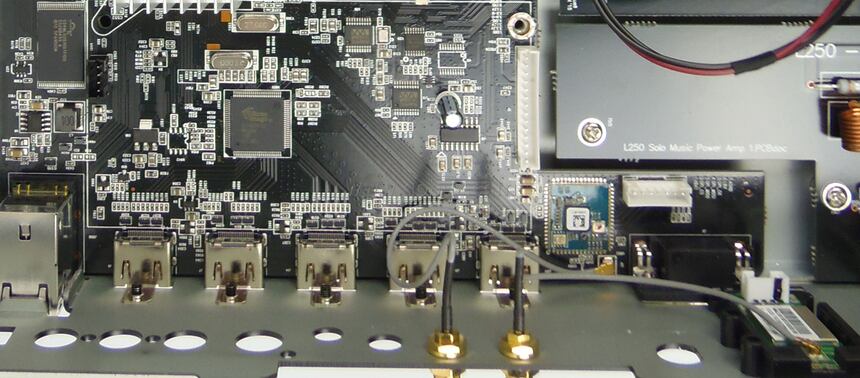
In the wake of all these elements, it’s the bulk of the digital processing that takes over, with a powerful digital signal processor topped with an aluminum fin heat sink. In the bottom right of the picture below, you can see the microcontroller, a STMicroelectronics STM32F417.
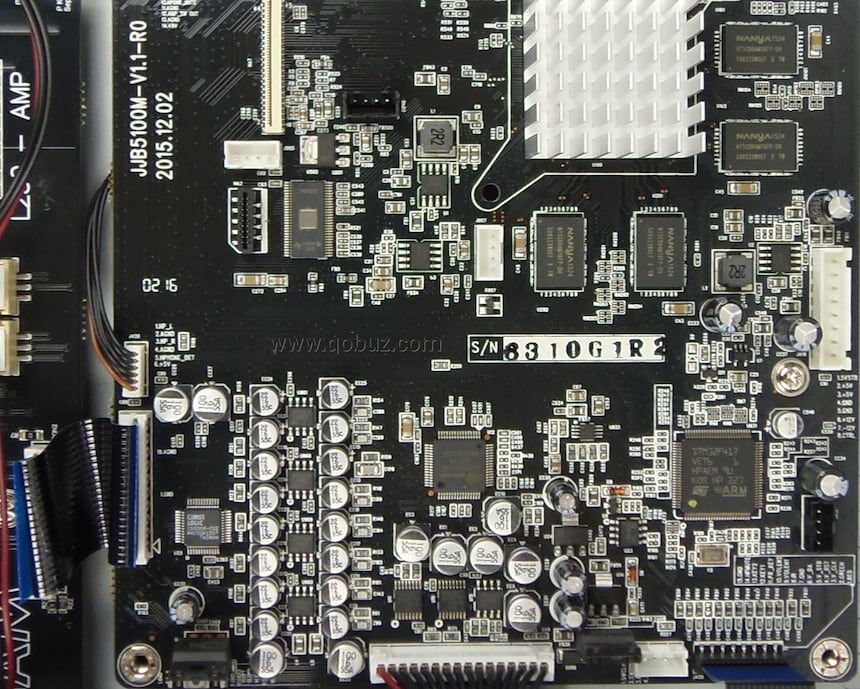
On its left, in the middle, is located the digital-to-analog converter, a Cirrus Logic CS42528. It contains eight channels compatible up to 24-Bit/192 kHz. Following that, you’ll find four high-performing Texas Instruments LM4562 dual operational amplifiers attacking a Cirrus Logic CS3308 eight channel volume control circuit.
Obviously, this part is common to the three version of this Solo all-in-one system, but only the left and right channel will be handled by the amplifier, since this is a stereo model. It operates in class G and uses ON Semiconductor NJL0281D (15A, 180W) and NJW1302 (15A, 200W) transistors. They are cooled down by a sturdy black anodized aluminum fin heat sink.
Sound
Since we’ve been doing testing grounds, we don’t remember ever being disappointed by the sound reproduction of an Arcam device, and this Solo Music all-in-one system effortlessly adds to the list.
What a pleasure it is to listen, by streaming Qobuz, to The Turkish March from the album Mozart Allegros spewing its notes with finesse and fluidity, letting the music flow without tension or harshness. This is some beautiful piano that we’re listening to, with a real feeling of natural sound. We’ll indeed stay with Mozart, with the Andante from the Symphony No. 40 performed by the Tafelmusik Baroque Orchestra ensemble conducted by Bruno Weil. The characteristic sound of the old-style chords from this orchestra is perfectly restituted by the Arcam Solo Music system, and we recognize effortlessly the sonic touch that Bruno Weil brings to this ensemble. Anyway, it sounds great without forgetting or favoring anything, in short it’s balanced, and then again, we take great pleasure listening to this music.
This great finesse of restitution also manifests itself in an obvious manner while listening to the American Quartet from the album Dvořák: American String Quartet & Quintet, Op. 96-97, where the instrumentalists’ playing deploy in a beautiful sound space that allows you to follow each and every one instrument, as well as appreciate all the subtlety of the performance and the art of the interpretation, while being carried away by a captivating musical flow.
With Claudio Capéo’s eponymous album, the singer’s voice is particularly pampered and reproduced with presence and precision, perfectly intelligible. The accompaniment knows its place without ever confusing the text, and the bass is incidentally not particularly powerful within this accompaniment.
You don’t have to fear anything either in the bass, the Arcam Solo Music has an answer for everything. With the bass-heavy album Tale Of Us, we didn’t feel the need to push it to its limits to rock the boomers from our Triangle Antal Anniversary speakers with vivacity, control and strength, which led us to quickly turn down the volume; and, then again, it displayed a certain finesse while handling the sound message located in the higher frequencies.
To conclude, this is a very nice all-in-one system. According to us, its price is very reasonable—note that it’s rare for us to comment on this subject—and it will please both analog and digital music lovers thanks to its great sound performances. On top of everything, we bestow it with our Qobuzism award.
Specifications (in French)
User Manual (in French)
PPL Audio Website (Importer, in French)



